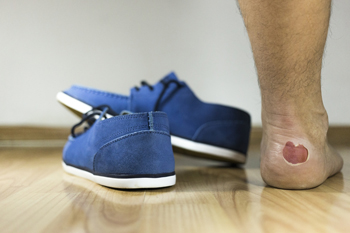Connect With Us
Blog
Possible Causes of Blisters on the Feet
Many people who enjoy running in marathons find that blisters tend to develop in different parts of their feet. It typically occurs as a result of excessive friction in a particular spot on the foot, and can cause pain and discomfort. When the small area of skin becomes damaged, the body’s natural defense is to form a small bubble over the raw skin. This is filled with fluid that protects the area as the healing process occurs. In many cases, it will gradually drain on its own as new skin forms underneath it. The friction may be caused by wearing shoes that do not fit correctly, or choosing to wear non-absorbent socks. It may help to cover the blister with an elastic bandage as running and daily activities are completed. If a blister on your foot has become infected, it is strongly advised that you speak with a podiatrist who can effectively treat this condition.
Blisters may appear as a single bubble or in a cluster. They can cause a lot of pain and may be filled with pus, blood, or watery serum. If your feet are hurting, contact one of our podiatrists of The Podiatry Center, PC. Our doctors can provide the care you need to keep you pain-free and on your feet.
Foot Blisters
Foot blisters are often the result of friction. This happens due to the constant rubbing from shoes, which can lead to pain.
What Are Foot Blisters?
A foot blister is a small fluid-filled pocket that forms on the upper-most layer of the skin. Blisters are filled with clear fluid and can lead to blood drainage or pus if the area becomes infected.
Symptoms
(Blister symptoms may vary depending on what is causing them)
- Bubble of skin filled with fluid
- Redness
- Moderate to severe pain
- Itching
Prevention & Treatment
In order to prevent blisters, you should be sure to wear comfortable shoes with socks that cushion your feet and absorb sweat. Breaking a blister open may increase your chances of developing an infection. However, if your blister breaks, you should wash the area with soap and water immediately and then apply a bandage to the affected area. If your blisters cause severe pain it is important that you call your podiatrist right away.
If you have any questions, please feel free to contact our office located in Millburn, NJ. We offer the newest diagnostic and treatment technologies for all your foot care needs.
Read more about Blisters on the FeetPossible Causes of Blisters on the Feet
Many people who enjoy running in marathons find that blisters tend to develop in different parts of their feet. It typically occurs as a result of excessive friction in a particular spot on the foot, and can cause pain and discomfort. When the small area of skin becomes damaged, the body’s natural defense is to form a small bubble over the raw skin. This is filled with fluid that protects the area as the healing process occurs. In many cases, it will gradually drain on its own as new skin forms underneath it. The friction may be caused by wearing shoes that do not fit correctly, or choosing to wear non-absorbent socks. It may help to cover the blister with an elastic bandage as running and daily activities are completed. If a blister on your foot has become infected, it is strongly advised that you speak with a podiatrist who can effectively treat this condition.
Blisters may appear as a single bubble or in a cluster. They can cause a lot of pain and may be filled with pus, blood, or watery serum. If your feet are hurting, contact one of our podiatrists of The Podiatry Center, PC. Our doctors can provide the care you need to keep you pain-free and on your feet.
Foot Blisters
Foot blisters are often the result of friction. This happens due to the constant rubbing from shoes, which can lead to pain.
What Are Foot Blisters?
A foot blister is a small fluid-filled pocket that forms on the upper-most layer of the skin. Blisters are filled with clear fluid and can lead to blood drainage or pus if the area becomes infected.
Symptoms
(Blister symptoms may vary depending on what is causing them)
- Bubble of skin filled with fluid
- Redness
- Moderate to severe pain
- Itching
Prevention & Treatment
In order to prevent blisters, you should be sure to wear comfortable shoes with socks that cushion your feet and absorb sweat. Breaking a blister open may increase your chances of developing an infection. However, if your blister breaks, you should wash the area with soap and water immediately and then apply a bandage to the affected area. If your blisters cause severe pain it is important that you call your podiatrist right away.
If you have any questions, please feel free to contact our office located in Millburn, NJ . We offer the newest diagnostic and treatment technologies for all your foot care needs.
Morton’s Neuroma Can Affect the Toes
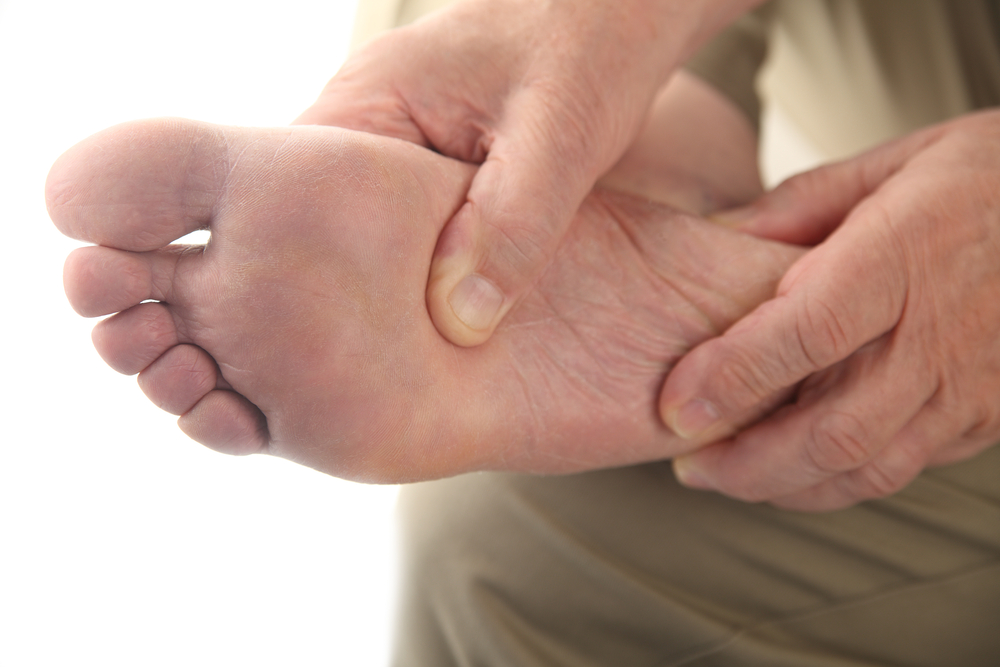 There are nerves that are located in each foot. If the nerve that is located between the third and fourth toes becomes inflamed, it may be referred to as Morton’s Neuroma. This condition may develop as a result of wearing shoes that do not have adequate room for the toes to move freely in, or from participating in high-impact sports. Some of the symptoms that are associated with Morton’s neuroma can include the sensation of stepping on a marble, pain and discomfort while walking, or feeling a burning or numbing sensation in the affected area. After a proper diagnosis is performed, which generally consists of having an X-ray or MRI taken, the correct treatment can begin. This may include a variety of options, which is why we advise that you seek the counsel of a podiatrist who can help you to determine which form of treatment is best for you.
There are nerves that are located in each foot. If the nerve that is located between the third and fourth toes becomes inflamed, it may be referred to as Morton’s Neuroma. This condition may develop as a result of wearing shoes that do not have adequate room for the toes to move freely in, or from participating in high-impact sports. Some of the symptoms that are associated with Morton’s neuroma can include the sensation of stepping on a marble, pain and discomfort while walking, or feeling a burning or numbing sensation in the affected area. After a proper diagnosis is performed, which generally consists of having an X-ray or MRI taken, the correct treatment can begin. This may include a variety of options, which is why we advise that you seek the counsel of a podiatrist who can help you to determine which form of treatment is best for you.
Morton’s neuroma is a very uncomfortable condition to live with. If you think you have Morton’s neuroma, contact one of our podiatrists of The Podiatry Center, PC. Our doctors will attend to all of your foot care needs and answer any of your related questions.
Morton’s Neuroma
Morton's neuroma is a painful foot condition that commonly affects the areas between the second and third or third and fourth toe, although other areas of the foot are also susceptible. Morton’s neuroma is caused by an inflamed nerve in the foot that is being squeezed and aggravated by surrounding bones.
What Increases the Chances of Having Morton’s Neuroma?
- Ill-fitting high heels or shoes that add pressure to the toe or foot
- Jogging, running or any sport that involves constant impact to the foot
- Flat feet, bunions, and any other foot deformities
Morton’s neuroma is a very treatable condition. Orthotics and shoe inserts can often be used to alleviate the pain on the forefront of the feet. In more severe cases, corticosteroids can also be prescribed. In order to figure out the best treatment for your neuroma, it’s recommended to seek the care of a podiatrist who can diagnose your condition and provide different treatment options.
If you have any questions, please feel free to contact our office located in Millburn, NJ. We offer the newest diagnostic and treatment technologies for all your foot care needs.
Read more about Morton's NeuromaMorton’s Neuroma Can Affect the Toes
 There are nerves that are located in each foot. If the nerve that is located between the third and fourth toes becomes inflamed, it may be referred to as Morton’s Neuroma. This condition may develop as a result of wearing shoes that do not have adequate room for the toes to move freely in, or from participating in high-impact sports. Some of the symptoms that are associated with Morton’s neuroma can include the sensation of stepping on a marble, pain and discomfort while walking, or feeling a burning or numbing sensation in the affected area. After a proper diagnosis is performed, which generally consists of having an X-ray or MRI taken, the correct treatment can begin. This may include a variety of options, which is why we advise that you seek the counsel of a podiatrist who can help you to determine which form of treatment is best for you.
There are nerves that are located in each foot. If the nerve that is located between the third and fourth toes becomes inflamed, it may be referred to as Morton’s Neuroma. This condition may develop as a result of wearing shoes that do not have adequate room for the toes to move freely in, or from participating in high-impact sports. Some of the symptoms that are associated with Morton’s neuroma can include the sensation of stepping on a marble, pain and discomfort while walking, or feeling a burning or numbing sensation in the affected area. After a proper diagnosis is performed, which generally consists of having an X-ray or MRI taken, the correct treatment can begin. This may include a variety of options, which is why we advise that you seek the counsel of a podiatrist who can help you to determine which form of treatment is best for you.
Morton’s neuroma is a very uncomfortable condition to live with. If you think you have Morton’s neuroma, contact one of our podiatrists of The Podiatry Center, PC. Our doctors will attend to all of your foot care needs and answer any of your related questions.
Morton’s Neuroma
Morton's neuroma is a painful foot condition that commonly affects the areas between the second and third or third and fourth toe, although other areas of the foot are also susceptible. Morton’s neuroma is caused by an inflamed nerve in the foot that is being squeezed and aggravated by surrounding bones.
What Increases the Chances of Having Morton’s Neuroma?
- Ill-fitting high heels or shoes that add pressure to the toe or foot
- Jogging, running or any sport that involves constant impact to the foot
- Flat feet, bunions, and any other foot deformities
Morton’s neuroma is a very treatable condition. Orthotics and shoe inserts can often be used to alleviate the pain on the forefront of the feet. In more severe cases, corticosteroids can also be prescribed. In order to figure out the best treatment for your neuroma, it’s recommended to seek the care of a podiatrist who can diagnose your condition and provide different treatment options.
If you have any questions, please feel free to contact our office located in Millburn, NJ . We offer the newest diagnostic and treatment technologies for all your foot care needs.
Wounds That Don't Heal Need to Be Checked
Wounds That Don't Heal Need to Be Checked
How Can I Support My Broken Toe as It Heals?
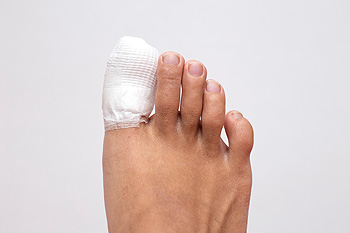 It is fairly common for a person to have broken their pinky toe. This can happen as a result of a heavy object falling on top of it, or possibly from stubbing it against a piece of furniture. When the pinky toe is broken, you may still be able to walk on it, however it can produce severe pain and discomfort. An effective treatment for a broken pinky toe may be referred to as buddy taping. This is done by taping the affected toe to the toe next to it. This procedure may help to support the broken toe as the healing process takes place. Severe fractures may produce a fever, and it may be necessary to perform surgery or to take pain medication. If you have broken your toe, please consult with a podiatrist who can properly treat a broken toe.
It is fairly common for a person to have broken their pinky toe. This can happen as a result of a heavy object falling on top of it, or possibly from stubbing it against a piece of furniture. When the pinky toe is broken, you may still be able to walk on it, however it can produce severe pain and discomfort. An effective treatment for a broken pinky toe may be referred to as buddy taping. This is done by taping the affected toe to the toe next to it. This procedure may help to support the broken toe as the healing process takes place. Severe fractures may produce a fever, and it may be necessary to perform surgery or to take pain medication. If you have broken your toe, please consult with a podiatrist who can properly treat a broken toe.
Broken toes may cause a lot of pain and should be treated as soon as possible. If you have any concerns about your feet, contact one of our podiatrists from The Podiatry Center, PC. Our doctors will treat your foot and ankle needs.
What Is a Broken Toe?
A broken toe occurs when one or more of the toe bones of the foot are broken after an injury. Injuries such as stubbing your toe or dropping a heavy object on it may cause a toe fracture.
Symptoms of a Broken Toe
- Swelling
- Pain (with/without wearing shoes)
- Stiffness
- Nail Injury
Although the injured toe should be monitored daily, it is especially important to have a podiatrist look at your toe if you have severe symptoms. Some of these symptoms include worsening or new pain that is not relieved with medication, sores, redness, or open wounds near the toe.
If you have any questions, please feel free to contact our office located in Millburn, NJ. We offer the newest diagnostic and treatment technologies for all your foot care needs.
Read more about What to Know About a Broken ToeHow Can I Support My Broken Toe as It Heals?
 It is fairly common for a person to have broken their pinky toe. This can happen as a result of a heavy object falling on top of it, or possibly from stubbing it against a piece of furniture. When the pinky toe is broken, you may still be able to walk on it, however it can produce severe pain and discomfort. An effective treatment for a broken pinky toe may be referred to as buddy taping. This is done by taping the affected toe to the toe next to it. This procedure may help to support the broken toe as the healing process takes place. Severe fractures may produce a fever, and it may be necessary to perform surgery or to take pain medication. If you have broken your toe, please consult with a podiatrist who can properly treat a broken toe.
It is fairly common for a person to have broken their pinky toe. This can happen as a result of a heavy object falling on top of it, or possibly from stubbing it against a piece of furniture. When the pinky toe is broken, you may still be able to walk on it, however it can produce severe pain and discomfort. An effective treatment for a broken pinky toe may be referred to as buddy taping. This is done by taping the affected toe to the toe next to it. This procedure may help to support the broken toe as the healing process takes place. Severe fractures may produce a fever, and it may be necessary to perform surgery or to take pain medication. If you have broken your toe, please consult with a podiatrist who can properly treat a broken toe.
Broken toes may cause a lot of pain and should be treated as soon as possible. If you have any concerns about your feet, contact one of our podiatrists from The Podiatry Center, PC. Our doctors will treat your foot and ankle needs.
What Is a Broken Toe?
A broken toe occurs when one or more of the toe bones of the foot are broken after an injury. Injuries such as stubbing your toe or dropping a heavy object on it may cause a toe fracture.
Symptoms of a Broken Toe
- Swelling
- Pain (with/without wearing shoes)
- Stiffness
- Nail Injury
Although the injured toe should be monitored daily, it is especially important to have a podiatrist look at your toe if you have severe symptoms. Some of these symptoms include worsening or new pain that is not relieved with medication, sores, redness, or open wounds near the toe.
If you have any questions, please feel free to contact our office located in Millburn, NJ . We offer the newest diagnostic and treatment technologies for all your foot care needs.
Read more about What to Know About a Broken ToeWhere Is Pain Felt With Tarsal Tunnel Syndrome?
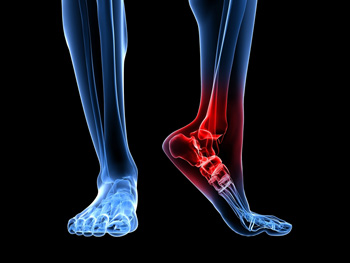 When there is extreme pressure exerted on the tibial nerve in the foot, it may cause a condition that is known as tarsal tunnel syndrome. This nerve is located behind the bump on the inside of the ankle. It is found within a band of tissue that forms a tunnel, and when this becomes inflamed, it may be indicative of tarsal tunnel syndrome. Some of the symptoms that are associated with this condition can consist of pain on the bottom of the foot, and this may often feel like a burning or tingling sensation. There are many treatment options available, depending on the severity of this ailment. If you have these symptoms, it is strongly suggested that you schedule a consultation with a podiatrist who can help you to determine what the best course of treatment is for you.
When there is extreme pressure exerted on the tibial nerve in the foot, it may cause a condition that is known as tarsal tunnel syndrome. This nerve is located behind the bump on the inside of the ankle. It is found within a band of tissue that forms a tunnel, and when this becomes inflamed, it may be indicative of tarsal tunnel syndrome. Some of the symptoms that are associated with this condition can consist of pain on the bottom of the foot, and this may often feel like a burning or tingling sensation. There are many treatment options available, depending on the severity of this ailment. If you have these symptoms, it is strongly suggested that you schedule a consultation with a podiatrist who can help you to determine what the best course of treatment is for you.
Tarsal tunnel syndrome can be very uncomfortable to live with. If you are experiencing tarsal tunnel syndrome, contact one of our podiatrists of The Podiatry Center, PC. Our doctors can provide the care you need to keep you pain-free and on your feet.
Tarsal Tunnel Syndrome
Tarsal tunnel syndrome, which can also be called tibial nerve dysfunction, is an uncommon condition of misfiring peripheral nerves in the foot. The tibial nerve is the peripheral nerve in the leg responsible for sensation and movement of the foot and calf muscles. In tarsal tunnel syndrome, the tibial nerve is damaged, causing problems with movement and feeling in the foot of the affected leg.
Common Cause of Tarsal Tunnel Syndrome
- Involves pressure or an injury, direct pressure on the tibial nerve for an extended period of time, sometimes caused by other body structures close by or near the knee.
- Diseases that damage nerves, including diabetes, may cause tarsal tunnel syndrome.
- At times, tarsal tunnel syndrome can appear without an obvious cause in some cases.
The Effects of Tarsal Tunnel Syndrome
- Different sensations, an afflicted person may experience pain, tingling, burning or other unusual sensations in the foot of the affected leg.
- The foot muscles, toes and ankle become weaker, and curling your toes or flexing your foot can become difficult.
- If condition worsens, infections and ulcers may develop on the foot that is experiencing the syndrome.
A physical exam of the leg can help identify the presence of tarsal tunnel syndrome. Medical tests, such as a nerve biopsy, are also used to diagnose the condition. Patients may receive physical therapy and prescriptive medication. In extreme cases, some may require surgery.
If you have any questions please feel free to contact our office located in Millburn, NJ. We offer the newest diagnostic and treatment technologies for all your foot and ankle needs.
Read more about Tarsal Tunnel SyndromeWhere Is Pain Felt With Tarsal Tunnel Syndrome?
 When there is extreme pressure exerted on the tibial nerve in the foot, it may cause a condition that is known as tarsal tunnel syndrome. This nerve is located behind the bump on the inside of the ankle. It is found within a band of tissue that forms a tunnel, and when this becomes inflamed, it may be indicative of tarsal tunnel syndrome. Some of the symptoms that are associated with this condition can consist of pain on the bottom of the foot, and this may often feel like a burning or tingling sensation. There are many treatment options available, depending on the severity of this ailment. If you have these symptoms, it is strongly suggested that you schedule a consultation with a podiatrist who can help you to determine what the best course of treatment is for you.
When there is extreme pressure exerted on the tibial nerve in the foot, it may cause a condition that is known as tarsal tunnel syndrome. This nerve is located behind the bump on the inside of the ankle. It is found within a band of tissue that forms a tunnel, and when this becomes inflamed, it may be indicative of tarsal tunnel syndrome. Some of the symptoms that are associated with this condition can consist of pain on the bottom of the foot, and this may often feel like a burning or tingling sensation. There are many treatment options available, depending on the severity of this ailment. If you have these symptoms, it is strongly suggested that you schedule a consultation with a podiatrist who can help you to determine what the best course of treatment is for you.
Tarsal tunnel syndrome can be very uncomfortable to live with. If you are experiencing tarsal tunnel syndrome, contact one of our podiatrists of The Podiatry Center, PC. Our doctors can provide the care you need to keep you pain-free and on your feet.
Tarsal Tunnel Syndrome
Tarsal tunnel syndrome, which can also be called tibial nerve dysfunction, is an uncommon condition of misfiring peripheral nerves in the foot. The tibial nerve is the peripheral nerve in the leg responsible for sensation and movement of the foot and calf muscles. In tarsal tunnel syndrome, the tibial nerve is damaged, causing problems with movement and feeling in the foot of the affected leg.
Common Cause of Tarsal Tunnel Syndrome
- Involves pressure or an injury, direct pressure on the tibial nerve for an extended period of time, sometimes caused by other body structures close by or near the knee.
- Diseases that damage nerves, including diabetes, may cause tarsal tunnel syndrome.
- At times, tarsal tunnel syndrome can appear without an obvious cause in some cases.
The Effects of Tarsal Tunnel Syndrome
- Different sensations, an afflicted person may experience pain, tingling, burning or other unusual sensations in the foot of the affected leg.
- The foot muscles, toes and ankle become weaker, and curling your toes or flexing your foot can become difficult.
- If condition worsens, infections and ulcers may develop on the foot that is experiencing the syndrome.
A physical exam of the leg can help identify the presence of tarsal tunnel syndrome. Medical tests, such as a nerve biopsy, are also used to diagnose the condition. Patients may receive physical therapy and prescriptive medication. In extreme cases, some may require surgery.
If you have any questions please feel free to contact our office located in Millburn, NJ . We offer the newest diagnostic and treatment technologies for all your foot and ankle needs.
More...
It's Time for Beautiful Feet
It's Time for Beautiful Feet
What Is the Bump on the Side of My Big Toe?
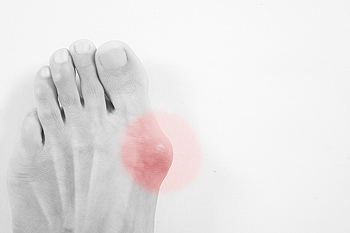 If you notice a bump on the side of your big toe, you may have what is referred to as a bunion. It may cause pain and discomfort, and it may be difficult to wear shoes that are typically worn on a weekly basis. Some of the symptoms that are generally associated with this condition can include calluses that form on top of the bunion, pain and swelling surrounding the affected area, and the skin may feel sore. Bunions have been known to be caused by wearing shoes that do not have ample room for the toes to move freely in. Additionally, there may be existing medical conditions such as gout or rheumatoid arthritis that can contribute to this condition. If you have developed a bunion, it is advised that you consult with a podiatrist who can offer you proper treatment options.
If you notice a bump on the side of your big toe, you may have what is referred to as a bunion. It may cause pain and discomfort, and it may be difficult to wear shoes that are typically worn on a weekly basis. Some of the symptoms that are generally associated with this condition can include calluses that form on top of the bunion, pain and swelling surrounding the affected area, and the skin may feel sore. Bunions have been known to be caused by wearing shoes that do not have ample room for the toes to move freely in. Additionally, there may be existing medical conditions such as gout or rheumatoid arthritis that can contribute to this condition. If you have developed a bunion, it is advised that you consult with a podiatrist who can offer you proper treatment options.
If you are suffering from bunions, contact one of our podiatrists of The Podiatry Center, PC. Our doctors can provide the care you need to keep you pain-free and on your feet.
What Is a Bunion?
A bunion is formed of swollen tissue or an enlargement of boney growth, usually located at the base joint of the toe that connects to the foot. The swelling occurs due to the bones in the big toe shifting inward, which impacts the other toes of the foot. This causes the area around the base of the big toe to become inflamed and painful.
Why Do Bunions Form?
Genetics – Susceptibility to bunions are often hereditary
Stress on the feet – Poorly fitted and uncomfortable footwear that places stress on feet, such as heels, can worsen existing bunions
How Are Bunions Diagnosed?
Doctors often perform two tests – blood tests and x-rays – when trying to diagnose bunions, especially in the early stages of development. Blood tests help determine if the foot pain is being caused by something else, such as arthritis, while x-rays provide a clear picture of your bone structure to your doctor.
How Are Bunions Treated?
- Refrain from wearing heels or similar shoes that cause discomfort
- Select wider shoes that can provide more comfort and reduce pain
- Anti-inflammatory and pain management drugs
- Orthotics or foot inserts
- Surgery
If you have any questions, please feel free to contact our office located in Millburn, NJ. We offer the newest diagnostic and treatment technologies for all your foot care needs.
Read more about BunionsWhat Is the Bump on the Side of My Big Toe?
 If you notice a bump on the side of your big toe, you may have what is referred to as a bunion. It may cause pain and discomfort, and it may be difficult to wear shoes that are typically worn on a weekly basis. Some of the symptoms that are generally associated with this condition can include calluses that form on top of the bunion, pain and swelling surrounding the affected area, and the skin may feel sore. Bunions have been known to be caused by wearing shoes that do not have ample room for the toes to move freely in. Additionally, there may be existing medical conditions such as gout or rheumatoid arthritis that can contribute to this condition. If you have developed a bunion, it is advised that you consult with a podiatrist who can offer you proper treatment options.
If you notice a bump on the side of your big toe, you may have what is referred to as a bunion. It may cause pain and discomfort, and it may be difficult to wear shoes that are typically worn on a weekly basis. Some of the symptoms that are generally associated with this condition can include calluses that form on top of the bunion, pain and swelling surrounding the affected area, and the skin may feel sore. Bunions have been known to be caused by wearing shoes that do not have ample room for the toes to move freely in. Additionally, there may be existing medical conditions such as gout or rheumatoid arthritis that can contribute to this condition. If you have developed a bunion, it is advised that you consult with a podiatrist who can offer you proper treatment options.
If you are suffering from bunions, contact one of our podiatrists of The Podiatry Center, PC. Our doctors can provide the care you need to keep you pain-free and on your feet.
What Is a Bunion?
A bunion is formed of swollen tissue or an enlargement of boney growth, usually located at the base joint of the toe that connects to the foot. The swelling occurs due to the bones in the big toe shifting inward, which impacts the other toes of the foot. This causes the area around the base of the big toe to become inflamed and painful.
Why Do Bunions Form?
Genetics – Susceptibility to bunions are often hereditary
Stress on the feet – Poorly fitted and uncomfortable footwear that places stress on feet, such as heels, can worsen existing bunions
How Are Bunions Diagnosed?
Doctors often perform two tests – blood tests and x-rays – when trying to diagnose bunions, especially in the early stages of development. Blood tests help determine if the foot pain is being caused by something else, such as arthritis, while x-rays provide a clear picture of your bone structure to your doctor.
How Are Bunions Treated?
- Refrain from wearing heels or similar shoes that cause discomfort
- Select wider shoes that can provide more comfort and reduce pain
- Anti-inflammatory and pain management drugs
- Orthotics or foot inserts
- Surgery
If you have any questions, please feel free to contact our office located in Millburn, NJ . We offer the newest diagnostic and treatment technologies for all your foot care needs.
Blog Archives
- June 2025
- May 2025
- April 2025
- March 2025
- February 2025
- January 2025
- December 2024
- November 2024
- October 2024
- September 2024
- August 2024
- July 2024
- June 2024
- May 2024
- April 2024
- March 2024
- February 2024
- January 2024
- December 2023
- November 2023
- October 2023
- September 2023
- August 2023
- July 2023
- June 2023
- May 2023
- April 2023
- March 2023
- February 2023
- January 2023
- December 2022
- November 2022
- October 2022
- September 2022
- August 2022
- July 2022
- June 2022
- May 2022
- April 2022
- March 2022
- February 2022
- January 2022
- December 2021
- November 2021
- October 2021
- September 2021
- August 2021
- July 2021
- June 2021
- May 2021
- April 2021
- March 2021
- February 2021
- January 2021
- December 2020
- November 2020
- October 2020
- September 2020
- August 2020
- July 2020
- June 2020
- May 2020
- April 2020
- March 2020
- February 2020
- January 2020
- December 2019
- November 2019
- October 2019
- September 2019
- August 2019
- July 2019
- June 2019
- May 2019
- April 2019
- March 2019
- February 2019
- January 2019
- December 2018
- November 2018
- October 2018
- September 2018
- August 2018
- July 2018
- June 2018
- May 2018
- April 2018
- March 2018
- February 2018
- January 2018
- December 2017
- November 2017
- October 2017
- September 2017
- August 2017
- July 2017
- June 2017
- May 2017
- April 2017
- March 2017
- February 2017
- January 2017
- December 2016
- November 2016
- October 2016
- September 2016
- August 2016
- July 2016
- June 2016
- May 2016
- April 2016
- March 2016
- February 2016
- January 2016
- December 2015
- November 2015
- October 2015
- September 2015
- August 2015
- July 2015
- June 2015
- May 2015
- January 2014
- December 2013
- November 2013
- October 2013
- September 2013
- August 2013
- July 2013
- June 2013
- May 2013
- April 2013
- March 2013
- February 2013
- January 2013
- December 2012
- November 2012
- October 2012
- September 2012
- August 2012
- July 2012
- June 2012
